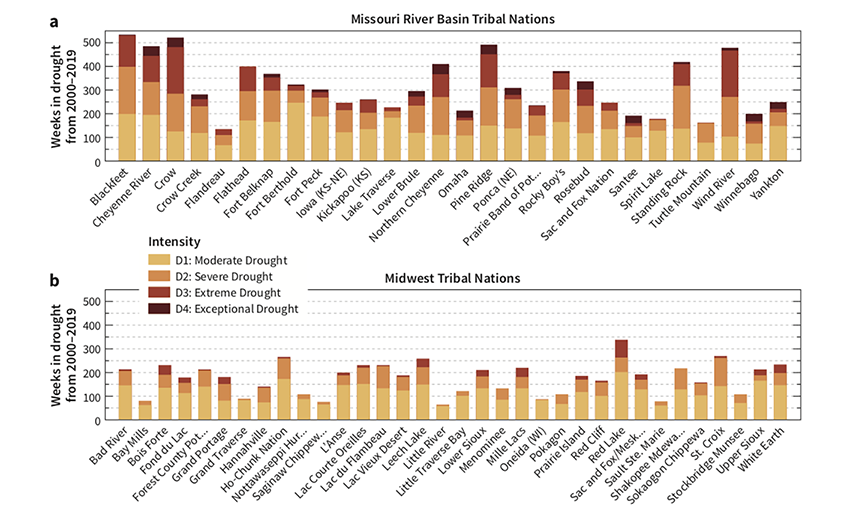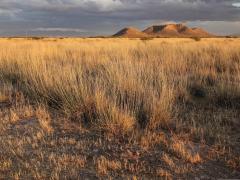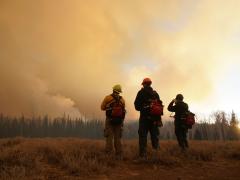NIDIS Tribal Drought Engagement Strategy
NIDIS just released its inaugural Tribal Drought Engagement Strategy, which presents guiding principles of tribal engagement, as well as key outcomes and tribal engagement activities for NIDIS and partners to implement in 2021 and beyond. This Strategy was developed by engaging with tribal nations within the Missouri River Basin and Midwest Drought Early Warning Systems (DEWS); however, the principles, as well as many of the activities, extend beyond these two regions.
Drought Impacts on Tribal Nations
Drought has been a constant concern for many regions of the United States, including the Midwest region and in the Missouri River Basin. Both of these areas have experienced increases in average temperatures (1–3°F) over the past few decades, with drought and flooding becoming more frequent and extreme (NCA 2018). Future projections predict that these changes will continue to impact these regions, with temperatures expected to rise by up to 3–5°F by the mid-21st century and up to 8°F by the end of the 21st century (NCA 2018).
Sixty-two federally recognized tribal nations exist within the Missouri River Basin and Midwest region, and all of them have experienced multiple episodes of drought since 2000, according to the U.S. Drought Monitor. Figure 1 shows the number of weeks tribal nations within the Missouri River Basin (1a) and Midwest (1b) have been in drought based on the severity levels of the U.S. Drought Monitor from 2000–2019. On average, tribal nations in the Missouri River Basin were in drought 30% of the time from 2000–2019, and almost all tribal nations have experienced all levels of drought at some point in the 20-year period. While drought has been longer and more severe in the Missouri River Basin, drought has also been an issue for Midwest tribal nations. On average, tribal nations in the Midwest were in drought 17% of the time from 2000–2019. Given the prevalence and reoccurrence of drought, information providers should engage with tribal nations and make drought monitoring and forecasting tools available for drought preparedness and response.

Goals of the NIDIS Tribal Drought Engagement Strategy
Indigenous experiences and perspectives of drought vary greatly across these two regions, as well as the entire United States. By integrating these diverse perspectives into NIDIS’ work, we will be able to foster a culturally appropriate engagement practice and work with tribal nations as equal partners in responding to drought.
In order to ensure the inclusion of indigenous perspectives in the implementation of our DEWS, NIDIS launched a Tribal Drought Engagement initiative in January 2019 in collaboration with the Masters of the Environment Program at University of Colorado-Boulder. The project aimed to strengthen relationships with tribal resource managers across the Missouri River Basin and Midwest DEWS regions in order to effectively deliver timely and relevant drought information.
The NIDIS Tribal Drought Engagement Strategy: 2021–2025 was developed following this project, which included a year of consultations with tribal resource managers across the two regions. These consultations helped identify critical engagement gaps and the actions that could be taken to address them. The engagement in these two DEWS will inform consultations with tribal nations as a foundation for scaling the Strategy to other regions.
Two types of information are encompassed in the Strategy. The first are a set of Guiding Principles of Engagement that capture important approaches that NIDIS wants to embody in partnerships with tribal nations. Following these principles are Key Outcomes and Activities that are organized around the five components of a DEWS (interdisciplinary research and applications; predictions and forecasting; observations and monitoring; planning and preparedness; and communications and outreach). The Strategy also provides a framework for integrating indigenous perspectives into the DEWS. Ultimately, implementation of the Strategy will lead to improved drought monitoring, forecasting, and resilience for tribal nations.
References
NCA. 2018. National Climate Assessment 2018. Retrieved from https://nca2018.globalchange.gov/.





